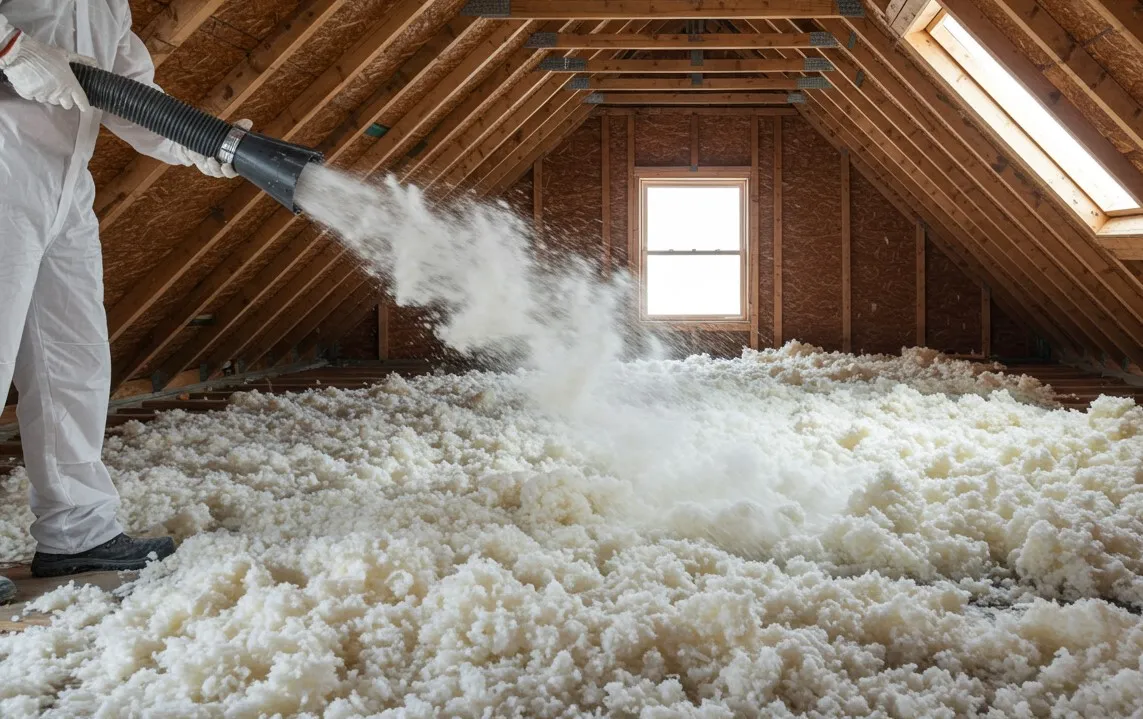
If you own a home or commercial building in Nevada, choosing the right attic insulation is key to keeping your space comfortable year-round and minimizing energy bills. Attic blown-in insulation offers several benefits, but deciding which type is best for your attic can depend on multiple factors—from the type of structure to the local climate in places like Sparks, Elko, or Winnemucca. In this guide, we’ll explore the various types of blown-in insulation for attics, helping you make an informed decision that works for your needs.
Blown-in insulation is often used in attics due to its versatility and effectiveness in sealing gaps and preventing heat transfer. Unlike batt or foam board insulation, blown-in insulation can reach tight spaces, ensuring a complete thermal seal. This matters because proper insulation plays a significant role in reducing your heating and cooling expenses and enhancing overall comfort.
When considering blown-in insulation for your attic, there are three primary types to choose from:
Let’s break down the pros, cons, and appropriate use cases for each type.
What It Is: Made primarily from recycled paper products, cellulose insulation is an environmentally friendly option that works well in a variety of settings. The material is treated with non-toxic chemicals to provide resistance to fire, mold, and pests.
Pros:
Cons:
Best Use Case: If you’re looking for an eco-friendly, dense, and effective insulation for attics in relatively dry climates, cellulose is a strong choice.
What It Is: Fiberglass insulation is made from small, spun fibers of glass. It’s one of the most common types of attic insulation and can be installed as batts or blown-in.
Pros:
Cons:
Best Use Case: Fiberglass insulation works well for attics with moderate temperature swings and lower moisture risks. It’s a good balance between affordability and performance.
What It Is: Mineral wool, often called rock wool, is made from volcanic rock and recycled steel. It offers several unique advantages, particularly in terms of safety.
Pros:
Cons:
Best Use Case: If you have concerns about fire safety or need superior soundproofing, mineral wool is a worthwhile investment, particularly in areas like Sparks or Elko, where fire prevention is a priority.
1. R-Value
The R-value measures insulation’s resistance to heat flow. The higher the R-value, the better the insulation performance. Nevada’s hot summers and cold winters call for higher R-values, especially in attic spaces where heat loss and gain can significantly impact energy use. Cellulose, fiberglass, and mineral wool all have different R-values per inch, typically ranging from R-3.2 to R-4.2 per inch.
2. Moisture Levels
If your attic is prone to moisture or leaks, opt for moisture-resistant materials like fiberglass or mineral wool over cellulose. In areas such as Eureka or Winnemucca, where weather fluctuations may occur, this could be a critical factor.
3. Budget
Cellulose tends to be the most affordable option, while mineral wool can be more costly due to its additional benefits. A balance between cost and performance should guide your decision. Weigh the long-term savings you might achieve with a more efficient insulator against the upfront costs.
4. Fire Safety
With Nevada’s climate being dry and fire risks being a concern, fire resistance is essential. Mineral wool is naturally fire-resistant, making it a smart choice if fire safety is a top priority. Fiberglass also provides good fire resistance without additives.
1. Inspection: Before insulation, it’s important to inspect the attic for potential issues such as roof leaks, ventilation problems, or existing insulation that may need removal.
2. Air Sealing: Sealing gaps and holes in the attic is crucial before installation. This prevents air leakage and ensures the new insulation performs as effectively as possible.
3. Blowing in Insulation: Specialized equipment is used to blow insulation into the attic. The insulation is applied uniformly to ensure proper coverage, without leaving any significant gaps.
4. Post-Installation Inspection: After installation, a final inspection ensures even distribution and adequate coverage.
While some homeowners consider DIY installation to save costs, hiring a professional like Nevada Urethane has significant advantages:
If you’re in Sparks, Eureka, Winnemucca, or the surrounding areas, Nevada Urethane provides specialized attic blown-in attic insulation services that cater specifically to the climate challenges in our region. Our team’s experience and knowledge of Nevada’s temperature extremes mean we can recommend the right type of insulation for your specific needs, whether it’s residential, commercial, or agricultural.
We understand how important it is to keep your space energy-efficient and comfortable—let us help make your attic a source of savings, not expenses.
Upgrading your attic insulation is one of the most effective ways to enhance your home’s energy efficiency, comfort, and safety. Choosing the right type of attic blown-in insulation in Sparks, NV can save you on energy costs for years to come.
Reach out to Nevada Urethane today to discuss your insulation needs. Our experts are ready to provide professional guidance and service that fits your budget and expectations. Call us at (775) 397-2820, or send us an email at [email protected].
Let us help make your home more energy-efficient and comfortable—starting with your attic.
1. What is the best blown-in insulation for attic spaces? Fiberglass, cellulose, and mineral wool are all effective options—the best choice depends on your attic’s conditions and your specific needs.
2. How much does blown-in attic insulation cost? The cost varies based on material and attic size. Contact us for a personalized estimate.
3. Can I install attic blown-in insulation myself? While possible, professional installation ensures better coverage, safety, and efficiency.
4. How long does attic blown-in insulation last? Attic blown-in insulation can last up to 20-30 years with proper care and maintenance.